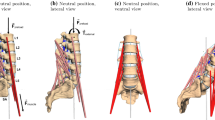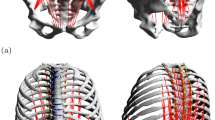Summary
A common method for load estimation in biomechanics is the inverse dynamics optimization, where the muscle activation pattern is found by minimizing or maximizing the optimization criterion. It has been shown that various optimization criteria predict remarkably similar muscle activation pattern and intra-articular contact forces during leg motion. The aim of this paper is to study the effect of the choice of optimization criterion on L4/L5 loading during static asymmetric loading. Upright standing with weight in one stretched arm was taken as a representative position. Musculoskeletal model of lumbar spine model was created from CT images of Visible Human Project. Several criteria were tested based on the minimization of muscle forces, muscle stresses, and spinal load. All criteria provide the same level of lumbar spine loading (difference is below 25%), except the criterion of minimum lumbar shear force which predicts unrealistically high spinal load and should not be considered further. Estimated spinal load and predicted muscle force activation pattern are in accordance with the intradiscal pressure measurements and EMG measurements. The L4/L5 spine loads 1312 N, 1674 N, and 1993 N were predicted for mass of weight in hand 2, 5, and 8 kg, respectively using criterion of mininum muscle stress cubed. As the optimization criteria do not considerably affect the spinal load, their choice is not critical in further clinical or ergonomic studies and computationally simpler criterion can be used.
Similar content being viewed by others
Abbreviations
- F:
-
muscle force
- P:
-
intraabdominal pressure force
- R:
-
L4/L5 spine load
- W:
-
body segment weight
- r:
-
radius vector
- G:
-
cost function
- N:
-
number of muscles
- PCSA:
-
physiological cross-section area
- σ:
-
muscle stress
- x, y, z:
-
coordinate system axes
References
Nigg BM, Herzog W. Biomechanics of the musculo-skeletal system. John Willey & Sons, Chichester, 1995
Vaughan CL. Theories of bipedal walking: an odyssey. J Biomech, 36: 513–523, 2002
Lloyd D, Besier FT. An EMG-driven musculoskeletal model to estimate muscle forces and knee joint movements in vivo. J Biomech, 36: 765–776, 2003
Tsirakos D, Baltzopoulos V, Bralett R. Inverse optimization: functional and physiological considerations related to the force sharing problem. Crit Rev Biomed Eng, 25(4&5): 371–407, 1997
Collins JJ. The redundant nature of locomotor optimization laws. J Biomech, 28(3): 251–267, 1995
Anderson FC, Pandy MGq. Static and dynamic optimization solutions for gait are practically equivalent. J Biomech, 34: 153–161, 2001
Winters JM. Terminology and foundations of movement science. In: Winters JM, Crago PE (eds.) Biomechanics and neural control of posture and movement. Springer-Verlang, New York, pp 1–35, 2000
Zajac EF, Winters JM. Modelling muskuloskeletal movement systems: joint and body segmental dynamics, muskuloskeletal and neuromuskular system. In: Winters JM, Woo SLY (eds.) Multiple muscle systems – biomechanics and movement organization. Spinger-Verlang, New-York, 121–148, 1990
Rasmussen J, Damsgaard M, Voigt M. Muscle recruitment by the min/max criterion – a comparative numerical study. J Biomech, 34: 409–415, 2001
Crownishield RD, Johnston RC, Andrews JG, Brand RA. A biomechanical investigation of the human hip. J Biomech, 11: 75–85, 1978
Davies A, Blakely ASH, Kidd C. Muscle. In: Human physiology. Churchill Livingstone, New York, 2001
Stokes IAF, Gardner-Morse M. Lumbar spinal muscle activation synergies predicted by multi-criteria cost function. J Biomech, 34: 733–740, 2001
Bean JC, Chaffin DB, Schultz AB. Biomechanical model calculation of muscle contraction forces: a double linear programming method. J Biomech, 21(1): 59–66, 1988
Hughes RE. Effect of optimization criterion on spinal force estimates during asymmetric lifting. J Biomech, 33: 225–229, 2000
Raikova RT. Investigation of the pecularities of two-joint muscles using a 3 DOF model of the human upper limb in the sagittal plane: an optimization approach. Comput Methods Biomech Biomed Engin, 4: 463–490, 2001
Raikova RT, Aladjov HT. Hierarchical genetic algorithm versus static optimisation – investigation of elbow flexion and extension movements. J Biomech, 35: 1123–1135, 2002
Prilutsky BI, Gregor RJ. Analysis of muscle cordination strategies in cycling. IEEE Trans Rehabil Eng, 8(3): 362–370, 2000
Stokes IAF, Gardner-Morse M. Quantitative anatomy of the lumbar musculature. J Biomech, 32: 311–316, 1999
Daniel M, Iglič A, Kralj-Iglič V, Konvičková S. Computer system for definition of the quantitative geometry of musculature from CT images. Comput Methods Biomech Biomed Engin, 8(1): 25–29, 2005
Ackerman MJ. Accessing the Visible Human Project. D-Lib Magazine. 1995; Available from: http://www.dlib.org/dlib/october95/10ackerman.html
Caon M. Voxel-based computational models of real human anatomy: a review. Radiat Environ Biophys, 42(4): 229–235, 2004
Cholewicki J, Juluru K, McGill SM. Intra-abdominal pressure mechanism for stabilizing the lumbar spine. J Biomech, 32(1): 13–17, 1999
Janda S, Valenta J. Mathematical model of the lumbar spine loads. J Mech Eng, 51(2): 86–91, 2000
Iglič A, Srakar F, Antolič V, Kralj-Iglič V, Batagelj V. Mathematical analysis of Chiari osteotomy. Acta Orthopedica Iugoslavica, 20: 35–39, 1990
Crownishield RD, Brand RA. A physiologically based criterion for muscle force prediction and locomotion. J Biomech, 14: 793–801, 1981
Heller MO, Bergmann G, Deuretzbacher G, Dürselen L, Pohl M, Claes L, et al. Musculo-skeletal loading conditions at hip during walking and stair climbing. J Biomech, 34: 883–893, 2001
Pedersen DR, Brand RA, Davy DT. Pelvic muscle and acetabular forces during gait. J Biomech, 30: 959–965, 1997
Kristan A, Mavčič B, Cimerman M, Iglis A, Tonin M, Slivnik T, et al. Acetabular loading in active abduction. IEEE Trans Rehabil Eng, 15(2): 252–257, 2007
Eaton JW. GNU octave manual. Network Theory Ltd, Bristol, UK, 1997
Ye Y. SOLNP user's guide: A nonlinear optimization in MATLAB. Department of Management Sciences, College of Business Administration, University of Iowa, Report, Aug. 1989
de Souza Castelo Oliveira A, Gonalves M. Lumbar muscles recruitment during resistance exercise for upper limbs. J Electromyogr Kinesiol, 19(5): 737–745, 2009
Schultz A, Andersson G, Ortengren R, Haderspeck K, Nachemson A. Loads on the lumbar spine. Validation of a biomechanical analysis by measurements of intradiscal pressures and myoelectric signals. J Bone Joint Surg Am, 64(5): 713–720, 1982
Raikova RT, Prilutsky BI. Sensitivity of predicted muscle forces to parameters of the optimization-based human leg model revealed by analytical and numerical analyses. J Biomech, 34: 1243–1255, 2001
Wilson S. Development of a model to predict the compressive forces on the spine associated with age-related vertebral fracture. Massachusetts Institute of Technology, 1994
Wilke HJ, Neef P, Caimi M, Hoogland T, Claes LE. New in vivo measurements of pressures in the intervertebral disc in daily life. Spine (Phila Pa 1976), 24(8): 755–762, 1999
Adams M, Bogduk N, Burton K, Dolan P (eds.) The biomechanics of back pain. Churchill Livingstone, Edinburgh, 2002
Cresswell AG, Oddsson L, Thorstensson A. The influence of sudden perturbations on trunk muscle activity and intra-abdominal pressure while standing. Exp Brain Res, 98(2): 336–341, 1994
Nordin M, Frankel VH (eds.) Basic biomechanics of the musculoskeletal system. Lea & Fibiger, Philadelphia, 1989
Rohlmann A, Graichen F, Bender A, Kayser R, Bergmann G. Loads on a telemeterized vertebral body replacement measured in three patients within the first postoperative month. Clin Biomech (Bristol, Avon), 23(2): 147–158, 2008
Author information
Authors and Affiliations
Corresponding author
Rights and permissions
About this article
Cite this article
Daniel, M. Role of optimization criterion in static asymmetric analysis of lumbar spine load. Wien Med Wochenschr 161, 477–485 (2011). https://doi.org/10.1007/s10354-011-0904-8
Received:
Accepted:
Published:
Issue Date:
DOI: https://doi.org/10.1007/s10354-011-0904-8




